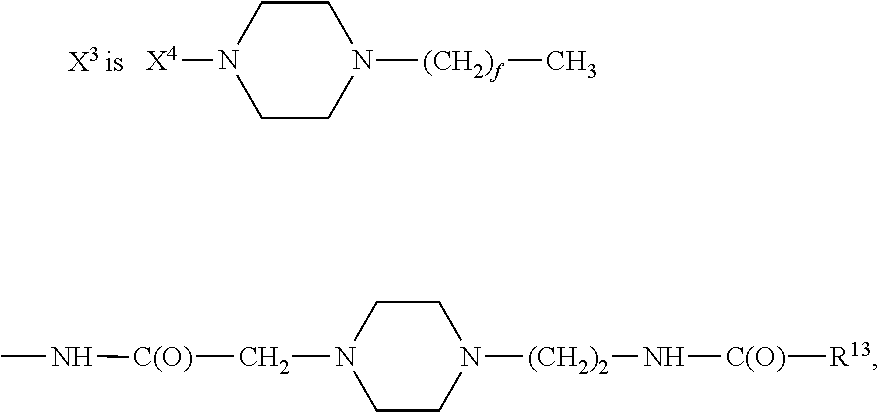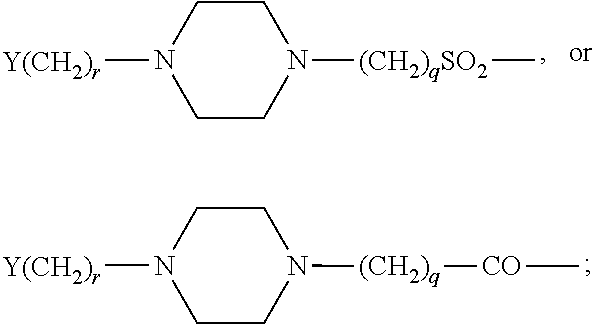Analogues of GLP-1
a technology of glp-1 and analogues, which is applied in the field of peptide analogues, can solve the problems of limiting the therapeutic potential of native glp-1, glp-1 is metabolically unstable,
- Summary
- Abstract
- Description
- Claims
- Application Information
AI Technical Summary
Benefits of technology
Problems solved by technology
Method used
Image
Examples
example 1
((3-fluoro-4-hydroxyphenyl-acetyl)7)hGLP-1(7-36)NH2(SEQ ID NO:31)
[0229]The title peptide, also referred to herein as ((3F, 4HO)-phenylacetyl7)hGLP-1(7-36)NH2; was synthesized on an Applied Biosystems model 433A peptide synthesizer (Foster City, Calif.) using Fluorenylmethyloxycarbonyl (Fmoc) chemistry. A Rink Amide-4-methylbenzylhydrylamine (MBHA) resin (Novabiochem., San Diego, Calif.) with substitution of 0.66 mmol / g was used. The Fmoc amino acids (AnaSpec, San Jose, Calif.) used were Fmoc-Ala-OH, Fmoc-Arg(Pbf)-OH, Fmoc-Asp(tBu)-OH, Fmoc-Gln(Trt)-OH, Fmoc-Glu(tBu)-OH, Fmoc-Gly-OH Fmoc-Ile-OH, Fmoc-Leu-OH, Fmoc-Lys(Boc)-OH, Fmoc-Phe-OH, Fmoc-Ser(tBu)-OH, Fmco-Tyr(tBu)-OH, Fmoc-Thr(tBu)-OH, Fmoc-Trp(Boc)-OH, and Fmoc-Val-OH. The last residue coupled to the resin was 3-Fluoro-4-hydroxyphenylacetic acid (Aldrich, Milwaukee, Wis.). The synthesis was carried out on a 0.1 mmol scale. The Fmoc groups were removed by treatment with 20% piperidine in N-methylpyrrolidone (NMP) for 30 min. In...
example 2
(Aib8,35, Arg26,34, Phe31, Pro37, Ser38,39)hGLP-1(7-39)-NH2(SEQ ID NO:1)
[0231]The title compound was synthesized substantially according to the procedure described for Example 1 using the appropriate protected amino acids (AnaSpec, San Jose, Calif.). At the end of the assembly of the protected peptide chain, an additional step was added to remove the N-terminal Fmoc-protecting group by using 20% piperidine in NMP for 30 min. The peptide resin was then washed, cleaved, purified and characterized using the procedures described for Example 1. Yield was 7.9%. Purity was 95.0%. Electro-spray ionization mass spectrometry (ESI-MS) analysis gave the molecular weight at 3629.40 (in agreement with the calculated molecular weight of 3628.00).
The following examples can be made according to the appropriate procedures described hereinabove:
[0232]Example 3 (Aib8,35,37, Arg26,34, Phe31, Asn38)hGLP-1(7-38)-NH2(SEQ ID NO:2)[0233]Example 4 ((4-imidazol-carbonyl)7)hGLP-1(7-36)NH2(SEQ ID NO:32)[0234]Exa...
PUM
| Property | Measurement | Unit |
|---|---|---|
| coupling time | aaaaa | aaaaa |
| time | aaaaa | aaaaa |
| flow rate | aaaaa | aaaaa |
Abstract
Description
Claims
Application Information
 Login to View More
Login to View More - R&D
- Intellectual Property
- Life Sciences
- Materials
- Tech Scout
- Unparalleled Data Quality
- Higher Quality Content
- 60% Fewer Hallucinations
Browse by: Latest US Patents, China's latest patents, Technical Efficacy Thesaurus, Application Domain, Technology Topic, Popular Technical Reports.
© 2025 PatSnap. All rights reserved.Legal|Privacy policy|Modern Slavery Act Transparency Statement|Sitemap|About US| Contact US: help@patsnap.com



